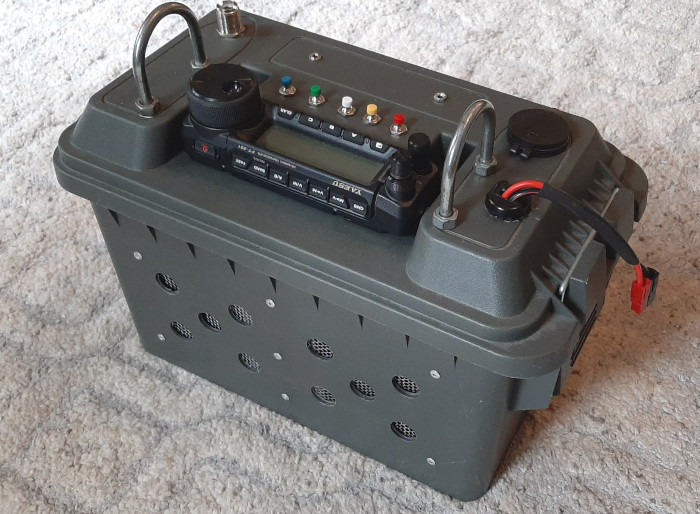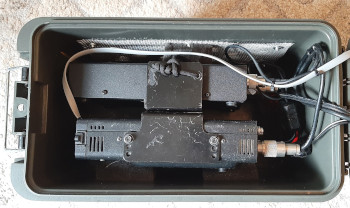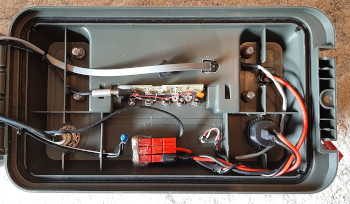My inner voice recently told me to stop building, re-building, re-engineering and modifying my outdoor operations kit and just go get on the air with it. I told my inner voice to hush-up; I need to do this. Each iteration of my design feels like the ultimate build – until it has been out to the field a few times and revealed its flaws.
I don’t know how many times I have gone through the build, re-build, re-engineer, modify cycle. Each time the end product overcomes the flaws in the previous version, but introduces new flaws – a little like the Windows operating system that I abandoned in favor of Linux over 10 years ago.
But, anyway, a project I read about online spurred me do it again. To paraphrase an early Rolling Stones song: “here comes your 19th go-box rebuild”. I could perhaps call it my No. 19 set, but that name is reserved for the best radio never to have been built for the ham radio market (and the first ham-modified military surplus radio I was ever exposed to many, many years ago).
So here is an account of how I constructed my newest go-box, based on a plastic container sold as a “50-cal ammo case”. I doubt the military ever used such a case for ammunition. It is quite different to the steel 50-cal ammo cases available from mil-surplus stores. However, it is lightweight and has just the right dimensions to contain the radio equipment I planned to use:
- Transceiver – Yaesu FT-891
- Autotuner – LDG Z11 Pro
- Remote Control Keypad – modified, DIY Yaesu FH-2
- Battery voltage monitor – Powerwerx
- Battery (external) – Bioenno 12AH LFP
- CW key (external) CWMorse CNC machined paddles
- Microphone (external, not currently used) – Yaesu MH-31
Here is the front-view of the “50-cal ammo case go-box”

Things to note about the design:
- The FT-891 control head is mounted in a convenient recess on the top of the go-box. This created a problem that was quickly solved. I use the side-mounted 1/8-inch jack to plug in my headphones, but the recess blocks access to this jack. The solution is detailed below.
- The DIY FH-2 remote keypad clone is integrated into the go-box. Only 5 buttons were implemented to access the FT-891s CW memories. In the field I often only use memory 1 to send a CQ message, but other messages are available if needed.
- The FT-891 body and LDG Z11 Pro autotuner are inside the go-box. Two challenges were created here. First, the radio generates heat inside a usually airtight box, so vent holes were cut and protected with metal mesh. Second, there is no access to the control buttons on the LDG tuner. I operate the tuner in fully automatic mode, set to engage if an SWR greater than 2:1 is encountered. The tuner can be easily removed if there is a need to access the buttons for any reason.
- The FT-891 has a headphone/speaker switch underneath the head unit . It is set to “headphone” and the headphone jack on the side of the head unit has been remoted to the front panel. This mutes the FT-891’s internal speaker which would have been inaudible inside the box anyway.
- All external connections – antenna, CW key, headphones and DC supply are mounted on the go-box lid. I chose to go with an external battery for two reasons. First, it wouldn’t fit inside the box and second: Bioenno batteries are rock-solid and reliable, but a hefty investment. I don’t have the budget to buy separate batteries for each of my field radios.
- Battery voltage monitor – I chose to use a panel mount Powerwerx unit. It doesn’t indicate Amp-hour consumption (I have a device that does that but chose not to use it). I have been using the Bioenno battery for a couple of years and grown accustomed to the start of the voltage decline indicating time for a re-charge. Besides, the Powerwerx unit also has a convenient USB-C jack with power delivery that I can use in the field to recharge my phone.
- The big ugly U-bolts on the top of go-box help protect the head controls and provide convenient handles for lifting the go-box. These plastic “ammo boxes” come with a plastic handle that I removed to get better access to the memory buttons.
Inside the go-box:


- In the left image above, you can see the FT-891 body and the LDG Z11 Pro tuner mounted together on brackets. They are held in place by friction fit with the type of dense black foam found inside equipment boxes. Sufficient space is provided to allow thermal convection currents to vent any heat generated by the radio through the holes drilled in the go-box.
- In the right image above, you can see the small circuit board on which is mounted the resistors used by the DIY clone FH-2. Each pushbutton on the front panel connects a pin in the ALC jack to ground through a specific value of resistor. The value of the resistor tells the radio which CW memory to play.
- Again in the right image above, you can see the FT-891 head unit connections. One RJ-12 cable connects the head unit to the body. I custom cut an RJ-12 cable to the right length and crimped a new connector on the cut end. You can also see how the headphone jack is remoted to the front panel through a hole cut in the plastic “ammo box”. A drill and my Weller soldering gun fitted with a plastic cutting attachment came in very handy in this build.
There is another mod on the drawing board already!
The FT-891 ammo-case-go-box is all set and ready for one of my usual CW deployments; typically a Parks-On-The-Air (POTA) activation. There are two revisions I need to make if I want to take it one step further.
- First, a microphone jack on the go-box front panel. I am not usually a phone/SSB operator but it would be nice to have the flexibility to do that. The FT-891 mic jack is on the body of the radio – inside the box. It is a pity there isn’t an alternative mic jack on the head unit. I have an Icom VHF/UHF radio that has a second mic jack on the head unit; it is a very convenient jack when mounting the radio inside a go-box.
- Second, a DATA jack on the go-box front panel. As I recently posted on HamRadioOutsideTheBox, I have discovered SOTAmat which allows me to self-spot on the POTA spotting page using FT8 mode over HF when I have no cell service or Internet available. Although I could open the go-box lid, lift the FT-891 body sufficiently to plug in my data interface box to the jack on the back, that would be an inconvenience out in the field.
Well, for now I have a rugged, reasonably environmentally protected go-box to work with. All accessories (key, battery, headphones etc) are carried inside a second plastic “50-cal ammo case”. Both fit neatly inside my NATO style rucksack which makes the rucksack quite comfortable to wear. So maybe I should rename this blog “Ham Radio Inside The Box”!
Help support HamRadioOutsidetheBox
No “tip-jar”, “buy me a coffee”, Patreon, or Amazon links here. I enjoy my hobby and I enjoy writing about it. If you would like to support this blog please follow/subscribe using the link at the bottom of my home page, or like, comment (links at the bottom of each post), repost or share links to my posts on social media. If you would like to email me directly you will find my email address on my QRZ.com page. Thank you!
The following copyright notice applies to all content on this blog.

This work is licensed under a Creative Commons Attribution-NonCommercial-NoDerivatives 4.0 International License.